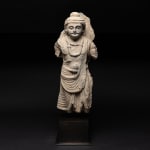Gandharan Standing Bodhisattva, 100 CE - 300 CE
Schist
61 x 25.9 cm
24 x 10 1/4 in
24 x 10 1/4 in
AM.0224
Further images
This magnificent bodhisattva comes from the ancient civilisation of Gandhara, located in the region encompassing modern north-eastern Afghanistan and north-western Pakistan. Buddhism flourished here from the 3rd century B.C. and...
This magnificent bodhisattva comes from the ancient civilisation of Gandhara, located in the region encompassing modern north-eastern Afghanistan and north-western Pakistan. Buddhism flourished here from the 3rd century B.C. and the region played an important role in transmitting the faith from India to other parts of Asia, especially China. Gandhara was particularly vulnerable to invasion because of its enviable position on the Silk Route. As a consequence artistic production betrays many outside influences, especially Hellenistic and Indian.
The popularity of bodhisattvas increased considerable in the early centuries of the first millennium. Originally portrayed solely as attendants of the Buddha, in time they appeared alone as figures of veneration in their own right. Bodhisattvas were believed to have accumulated enough merit to enter Nirvana. However, owing to their compassion, they chose to remain in the earthly realm to help others end the cycle of birth and rebirth. In contrast to images of the modestly attired Buddha, Bodhisattvas are usually recognisable through the wealth and elaborateness of their clothing and jewellery. This sculpture is no exception. Wearing an Indian style dhoti, the naked torso is adorned with elaborate Scythian style jewellery including a wide torque around the neck, a beaded necklace and a string with amulets draped diagonally across the body. Twisted cords adorn the hair which is plaited at either side. Carved in very high relief, rather than in the round, this figure may one have adorned a stupa or monastic enclosure. It is carved from schist, one of the materials most frequently deployed by Gandharan artists. The moustache is one of the most easily recognisable features of Gandharan Buddhist imagery and was largely confined to this locality. Despite damage to the arms, the figure is in remarkable condition and the carving, especially the drapery folds is of exceptional quality.
The popularity of bodhisattvas increased considerable in the early centuries of the first millennium. Originally portrayed solely as attendants of the Buddha, in time they appeared alone as figures of veneration in their own right. Bodhisattvas were believed to have accumulated enough merit to enter Nirvana. However, owing to their compassion, they chose to remain in the earthly realm to help others end the cycle of birth and rebirth. In contrast to images of the modestly attired Buddha, Bodhisattvas are usually recognisable through the wealth and elaborateness of their clothing and jewellery. This sculpture is no exception. Wearing an Indian style dhoti, the naked torso is adorned with elaborate Scythian style jewellery including a wide torque around the neck, a beaded necklace and a string with amulets draped diagonally across the body. Twisted cords adorn the hair which is plaited at either side. Carved in very high relief, rather than in the round, this figure may one have adorned a stupa or monastic enclosure. It is carved from schist, one of the materials most frequently deployed by Gandharan artists. The moustache is one of the most easily recognisable features of Gandharan Buddhist imagery and was largely confined to this locality. Despite damage to the arms, the figure is in remarkable condition and the carving, especially the drapery folds is of exceptional quality.











